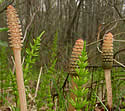Equisetum arvense (Field Horsetail)
| Also known as: | Common Horsetail |
|---|---|
| Genus: | Equisetum |
| Family: | Equisetaceae (Horsetail) |
| Life cycle: | perennial |
| Origin: | native |
| Habitat: | part shade, shade, sun; ditches, roadsides, moist woods |
| Fruiting season: | early to mid spring |
| Plant height: | 6 to 24 inches |
| Wetland Indicator Status: | GP: FAC MW: FAC NCNE: FAC |
| MN county distribution (click map to enlarge): |  |
| National distribution (click map to enlarge): |  |
Pick an image for a larger view. See the glossary for icon descriptions.
Detailed Information
Leaves and stems: 
![[photo of sheath and first internode]](/udata/r9ndp23q/ferns/equisetum-arvense_0710_194327-t.jpg) The sterile stem is green and has whorled branches that are spreading to ascending. The “leaves” are reduced to a sheath that surrounds the stem with 4 to 14 black/brown teeth at the top, often with 2 or 3 teeth joined along an edge. The stem has a small central cavity; branches are solid (not hollow) and 3 or 4 angled. The first sheath on the branch (aka first internode) has 3 or 4 teeth. The first branch internode is distinctly longer than the stem sheath.
The sterile stem is green and has whorled branches that are spreading to ascending. The “leaves” are reduced to a sheath that surrounds the stem with 4 to 14 black/brown teeth at the top, often with 2 or 3 teeth joined along an edge. The stem has a small central cavity; branches are solid (not hollow) and 3 or 4 angled. The first sheath on the branch (aka first internode) has 3 or 4 teeth. The first branch internode is distinctly longer than the stem sheath.
Fruit: 
![[photo of spore cone]](/udata/r9ndp23q/pd3/equisetum-arvense-9437-8-t.jpg) Fertile stems are not like the sterile stems, identified by the ½ to ½-inch, blunt-tipped cone at the tip of the stem, stout flesh-colored stem, and lack of branches. The teeth on the stem sheath are much larger than on the sterile stem. Fertile stems are seen only in early spring and whither away after releasing the spores. Spores are white.
Fertile stems are not like the sterile stems, identified by the ½ to ½-inch, blunt-tipped cone at the tip of the stem, stout flesh-colored stem, and lack of branches. The teeth on the stem sheath are much larger than on the sterile stem. Fertile stems are seen only in early spring and whither away after releasing the spores. Spores are white.
Notes:
Field Horsetail is something of a weedy species, often found along grassy roadsides and paths, spreading both by spores and vegetatively through rhizomes, and may create large colonies. It may be confused with Marsh Horsetail (Equisetum palustre), which has 5 or 6 teeth on the branch sheath and its first branch internode is shorter than the stem sheath. Also similar is Meadow Horsetail (Equisetum pratense), which, like E. arvense, has 3 or 4 teeth on the branch sheath, but its first internode on the lowest branch is shorter than the stem sheath and branches are spreading to drooping (not ascending). Note that it is important to look at the lowest branch when trying to determine if the first internode is longer or shorter than the stem sheath. On E. pratense; the first internode on branches further up the stem may be as long as or very slightly longer than the stem sheath. Field Horsetail is not very picky about habitat and may be found in shady woods or sunny open areas, frequently in disturbed soils. The sterile stem growth habit varies accordingly, with long, spreading branches (more similar to E. pratense) in moister, shadier locales and growing prostrate or almost shrub-like with multiple stems from the base in sunnier, drier soil.
Native Plant Nurseries, Restoration and Landscaping Services ↓
More photos
 Field Horsetail plants
Field Horsetail plants Field Horsetail in early spring
Field Horsetail in early spring plants with multiple stems from the base
plants with multiple stems from the base Field Horsetail spreading across a disturbed sandy beach
Field Horsetail spreading across a disturbed sandy beach a roadside colony of Field Horsetail
a roadside colony of Field Horsetail Field Horsetail in a gravel pit
Field Horsetail in a gravel pit Field Horsetail in moist woods
Field Horsetail in moist woods sterile and fertile stems
sterile and fertile stems
Photos by K. Chayka taken in Aitkin and Ramsey counties. Photos courtesy Peter M. Dziuk taken in Aitkin and Anoka counties.
Comments
Have you seen this plant in Minnesota, or have any other comments about it?
on: 2015-05-09 15:58:11
How do I get rid of it??
on: 2017-07-06 07:20:51
I was wondering if horsetail found in Mn can be Brewed into tea? I only find the kind that are the sticks that look like little bamboo . Thanks for your help :)
on: 2023-05-29 09:56:28
Transplanted a few to my shoreline buffer. Pretty in spring and is spreading throughout.
on: 2023-07-09 13:31:41
I have a 20' area on my beach that has been left natural. It is full of horsetail. The plant is now invading my beach. Is there any plant that I could introduce to choke out the horsetail? What can I do to keep it under control? If I disrupt the plants on the beach will that keep them from spreading?
on: 2023-07-09 22:11:02
Deborah, you wanted it natural so the horsetail is doing what comes naturally. :) Have you tried just pulling the excess out? BTW, pretty much any plant you introduce to keep the horsetail out will likely become an aggressor itself.






